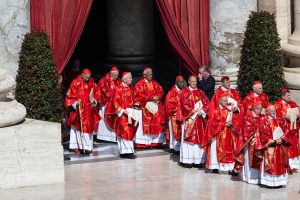By Pete Phillips
The coronavirus pandemic forced churches across the UK to start offering services and worship digitally over the internet. This process over time is likely to accelerate the disruption and extension of core practices of Christian faith.
Introduction
From the start of the coronavirus lockdown, churches in England have gone online. Of course, this is nothing new and the process of digital innovation has been comprehensively mapped by academics, including Heidi Campbell and Christopher Helland.
But this rather slow and purposeful process has been shifted into a different gear by religious professionals – across all faiths – taking their services, celebrations and prayers online because of the Covid-19 pandemic.
In an essay prepared for Heidi Campbell’s Covid-19 ebook The Socially Distant Church: Going Online in a Time of Pandemic, I have argued that online engagement has three phases. Building on disruptive innovation theory and conversations with Kevin Bennett, Premier Christian Radio’s director of operations, I suggest these stages can be mapped across time, media usage and theology:
- Enabling. The church enables offline practices to operate in an online setting. So, for example, churches offer household celebrations of the Eucharist but limit it to the celebrant and their household members receiving bread and wine.
- Extending. The church extends its practice online. For example, several denominations have reversed previous prohibitions on online communion and have allowed their ministers to share bread and wine with online congregations.
- Disrupting. The church disrupts existing practices through developing these practices, for example enabling followers to participate in a celebration of communion at different times, rather than all together.
Enabling
For some time, churches initially presented their church services as normal but without a congregation present. In Anglican and Roman Catholic churches, Eucharists/masses were offered and indeed continue to be offered either in sanctuaries linked to residential accommodation or in adapted rooms within clergy houses.
This enabling of current practice is facilitated by both denominations holding to the idea of spiritual communion from Thomas Cranmer’s Book of Common Prayer – that a congregant who is unable to receive the bread and wine physically can receive the spiritual benefit of the sacrament through prayer.
This practice, modelled also in the official virtual (the wrong term!) services offered by the Church of England and the BBC, have been heavily adapted to the current broadcast culture. Masses are represented on the television for the consumption of viewers. This is an offline practice present online through consumption of Netflix, YouTube, etc. But it is a process of consumption rather than interaction. This practice has continued across the early phases of the lockdown and is also now witnessed within the Methodist Church.
In a secondary theological process, the churches that do not support online communion have also promoted a fast from the Eucharist as a form of solidarity with the suffering of those suffering from Covid-19 or seeking to ameliorate the problems of the pandemic.
Extending
The shift to the lockdown of church premises meant that the most worship services could no longer reflect practices within the church. As such, those developing acts of worship needed to extend into online practices.
Moreover, a good deal of weight was put into the need for community engagement to ameliorate the potential breakdown of church community within the lockdown.
This was seen as an alternative methodology to the broadcast mentality of the larger denominations, although it has been the practice of many local churches. Indeed, while the Methodists advocate watching services from three large churches (Wesley’s Chapel, Methodist Central Hall and Swan Bank, Stoke-on-Trent), many alternative sites have been developed.
This shift to community models has tended to be reflected in two strands. First, many churches have developed participatory worship where different members of the church community film elements of the service in their homes, including elaborate choir pieces, and this is then edited together with live material from the church leader working from their own home. The investment of time in these activities is huge both in the production of the raw footage but also in the time and technical expertise needed to piece together the final broadcast footage. Many churches are drawing heavily on their tech teams and the availability of high-bandwidth high-data broadband – both benefits of living in a technologically rich country.
Second, several churches have made good use of Zoom or Microsoft Teams for both Sunday worship as well as Bible studies or virtual coffee shops. So, former BBC producer Andrew Graystone’s church in Longsight, Manchester, meets on Zoom. You need an invitation to attend. Members of the public are not normally accepted (although other Zoom services have been open and experienced the problem of Zoombombing). This provides a rich experience for community engagement with families zooming together and different members of the community interacting live in leading different aspects of the service.
Disrupting
For some, however, there is the need to engage even further with disruptive innovation in our church/religious practices.
Jonny Baker, who works for the Church Missionary Society, has published a blog pointing to the clerical domination involved in withholding the sacrament from congregants and the prohibition of online communion. Others have successfully argued with denominations to allow online communion in extremis during the pandemic. Others have creatively adapted current liturgies to allow for congregants who decide to bring their own bread and wine to the table during the church’s broadcast eucharists.
Since the broadcast link is usually one way, who is to stop disruptive innovation on the part of the congregation? Indeed, one vicar has rejoiced at pictures of congregational disruption with her picture in the background on the iPad.
Disruption is not just from the side of authority; disruption also happens as lay people engage in new forms of religious activity. Indeed, it is likely that such disruption will increase in coming weeks as the lockdown continues.
Growth amid the change?
As churches went online in much larger numbers, media reports began to emerge of churches reporting a huge increase in the numbers of people now watching their online services.
I had already received tweets noting this same phenomenon – that a church with a congregation of 30 had had 100 attending online with further views in the coming days. Indeed, there was even an ITV Meridian broadcast singling out two churches in Brighton experiencing huge increases to their already large congregations.
This became a media phenomenon in the early days and in various press interviews I have been asked to explain what is happening. A number of factors may be coming into play in what might be an urban myth or Christian hopefulness:
- Most Facebook views are generated after someone has viewed the feed for three seconds. As such, all the main figure tells you is that that number of people (those unique viewers) might have seen three seconds of your video. More number-crunching is needed to determine the real figures – see below.
- Lots of churches, especially in rural communities with older congregations are simply not engaged in creating online worship, although many of their church leaders have been emailing devotions, creating sermons on the telephone and distributing Bible study materials as much as possible. But it may be that the numbers are inflated by visitors from other churches.
- Family members may be choosing to view their parents, siblings, children or other family “performing on the telly”. With social isolation, such interaction is increasingly important and needed.
- Moreover, one view may not equate to one viewer. It may do. But it may be people watching together or in family groups. More research needs to be done on devices used, since mobile interactions would normally be sole viewers, but tablet or laptop interactions could be multiple viewers. So, the viewing figures below may need to be increased!
- Some people may have come into contact with your church and decided, for whatever reason, to pop in and see what is happening online. After all, online engagement is a lot less threatening than offline engagement. Indeed, Tim Hutchings’s 2017 book, Creating Church Online, has noted that online activity does not replace offline activity but supplements and usually strengthens offline. So, Life.Church TV, one of the largest multisite churches in the United States (now somewhat replicated in Everyday Church in London) runs an online interactive-broadcast service as a form of evangelism that successfully attracts many new converts into its offline church congregations.
Many of the points above have a lot of anecdotal evidence around them. So, ministers look down the names associated with the livestream and notice new names. This happens across the world, not just in the UK. But is there a better way than anecdotal evidence?
Ian Britton works for Premier Christian Radio and is a church member in Gateshead. His local church has about 40 members and a normal attendance of about 60. He noted that its first online services during the pandemic attracted much larger numbers of viewers: 365 on 22 March, 511 on 29 March. As such, there was an upward trajectory and Ian decided to do a social experiment for two Easter services – a £5 Facebook ad aimed at those who lived within a kilometre of the church.
The result was that the two services highlighted in the advert drew about 750 additional views (note this is potentially only the three-second views noted above) from a reach of about 1,600 people. The age profile of those who responded was weighted towards older people and two-thirds were women. Views of the service were spread across the day and so evidently people were viewing as they saw the advert or returning later. Meanwhile, a service not included in the advert also saw viewing figures of about 350:
- 5 April Sunday Service: 925 views
- 10 April Good Friday Service: 371 views
- 13 April Easter Sunday Service: 1,200 views
- Average viewing of sermon videos previously: about 200
- Average viewing of previous services during the pandemic: 400+
Clearly this research suggests that there is an increase in numbers while also offering some caveats about Facebook unique views and how long people are staying to watch. More in-depth research would be needed to confirm that the new viewers are watching a good portion of the service.
The Rev Dr Pete Phillips is director of the Centre for Digital Theology, Durham University




















